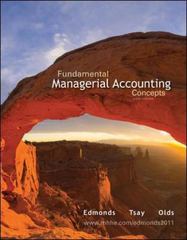Question
It is July 15, 2020, and you, CPA, have just met with clients Richard and Nancy Nickerson who are seeking business advice. Richard is an
It is July 15, 2020, and you, CPA, have just met with clients Richard and Nancy Nickerson who are seeking business advice. Richard is an engineering professor at the local college and Nancy is a substitute teacher. Nancy has always wanted to run her own business and has approached Sassy Shoes Ltd. (Sassy) to investigate the possibility of obtaining a Sassy franchise.
The Nickersons advised you that they have no prior business experience and that they need guidance. The only thing they know for sure is that they plan to incorporate the new business. A friend, who is a CPA, has explained the tax implications of a corporate structure. They are confident in her advice and do not need you to advise them on any tax matters.
They provided you with extracts of the draft franchise agreement with Sassy (Appendix I) and a five-year discounted earnings projection prepared by Sassy (Appendix II). They also met with two other Sassy franchisees to gain some further insight and provided you with notes on their meetings as well as other information in Appendix III.
Richard's current salary is $125,000 a year; Nancy has been earning $20,000 a year from substitute teaching. They are concerned that they will not be able to replace Nancy's earnings with income from Sassy, so they would like you to calculate break-even sales for the first year (excluding any start-up costs).
Appendix I
Extracts of draft franchise agreement
1. Parties ? Sassy Shoes Ltd., the franchisor, and Richard and Nancy Nickerson, the franchisee.
2. Duration ? September 1, 2020, to August 31, 2025, renewable for a further five years at the option of the franchisee. Upon renewal, no further "initial" franchise fee is required; only the ongoing franchise fee would be payable.
3. Premises ? To be subleased by the franchisor to the franchisee. The rent for 800 square feet is a minimum of $50,000 per annum ($40 per square foot plus a service charge of $22.50 per square foot); if annual total sales are higher than $400,000, another 2% on the portion of sales over $400,000 is due at year end.
4. Territory ? The franchisor agrees not to open Sassy franchise stores within a 10-square-kilometre radius of the premises.
5. Initial franchise fee ? $60,000 payable upon signing the contract. The fee entitles the franchisee to use the Sassy logo for the term of the contract.
6. Initial investment ? An amount of $150,000 is to be paid by September 1, 2020, for initial inventory ($110,000) and leasehold improvements ($40,000).
7. Royalty (ongoing franchise fee) ? A monthly fee of 5% of gross sales.
8. Franchise services ? The franchisor will design and supervise the construction of the leasehold improvements and will provide initial training in the store operation, administration, and inventory management. Purchasing advice (for example, styles and sizes) for the first operating year will be provided, as well as a detailed operating manual.
9. Accounting ? The franchisee is responsible for maintaining an accounting system and for providing financial information on which the lease and royalty payments will be based. Audited financial statements must be provided to the franchisor no later than two months after year end.
10. Franchise ? The franchisee is restricted to selling only women's shoes and related products in the Sassy store. All inventory purchases must be made through Sassy. The franchisee agrees to spend approximately 1% of sales on local advertising.
11. Resale ? The franchisee is not permitted to sell the franchise to a third party during the term of the agreement.
12. Breach of contract ? The franchisor may terminate the franchise agreement if the franchisee fails to comply with the terms of the contract.

Step by Step Solution
There are 3 Steps involved in it
Step: 1

Get Instant Access to Expert-Tailored Solutions
See step-by-step solutions with expert insights and AI powered tools for academic success
Step: 2

Step: 3

Ace Your Homework with AI
Get the answers you need in no time with our AI-driven, step-by-step assistance
Get Started


